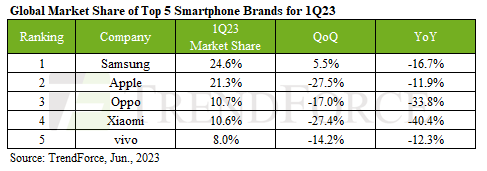The global economic downturn continues to cast its shadow over consumer confidence, and the impact on the smartphone market is nothing short of dramatic. In the first quarter of 2023, the industry experienced a dual setback as both smartphone production and shipments suffered significant declines. The latest report from TrendForce reveals some jaw-dropping data on global smartphone production in Q1 2023, when compared to the past decade. The production volume of smartphones in the first quarter of 2023 hit rock bottom, plunging to a mere 250 million units. This mind-boggling 19.5% year-on-year decrease is not only the largest annual drop since 2014 but also marks a historic low in quarterly production.
On the other hand, Q1 2023 marked the seventh consecutive quarter of decline, with global smartphone shipments plummeting by an astounding 14.6% YoY to 268.6 million units.
Let’s delve into the production landscape of the world’s leading smartphone companies in Q1 2023.
Global smartphone production Q1 2023 by company
Samsung reported a modest 5.5% QoQ increase in production during Q1 2023, reaching 61.5 million units. This quarterly growth is primarily driven by the launch of the Galaxy S23 series. However, the Korean giant observed a notable 16.7% YoY decline in smartphone production worldwide. Looking ahead, TrendForce predicts a nearly 10% decline in Q2 production, citing weakening demand for new models as the primary factor behind this projected decrease.
Apple iPhone production declined a massive 27.5% QoQ and 11.9% YoY in Q1 2023, totalling 53.3 million units. The 2022 launched iPhone 14 series accounted for approximately 78% of the total global iPhone production, showing improvement compared to the same period last year. The Cupertino giant predicted a bumpy road ahead, with a projected 20% reduction looming in Q2 2023.
In Q1 2023, Oppo claimed the third position in terms of smartphone production volume, manufacturing 26.8 million units. The Chinese brand reported a significant 17% QoQ and 33.8% YoY decline in production globally. These strategic decisions to reduce production were driven by the challenging market conditions and the necessity to make inventory adjustments.
However, there is optimism on the horizon for Oppo. TrendForce predicts a remarkable surge of over 30% in Q2 production, thanks to successful inventory management strategies and a moderate resurgence in demand, particularly in Southeast Asia and other regions.
It is worth noting that Oppo’s success is not limited to China. Alongside continually strengthening its market share for high-end models in the domestic market, Oppo has also achieved notable sales triumphs in South Asia, Southeast Asia, and Latin America. Impressively, its overseas market accounts for nearly 60% of its total sales, emphasizing the brand’s growing presence and popularity in international markets.
Xiaomi’s smartphone production hit the most during the first quarter of 2023. The Chinese giant reported a massive 27.4% QoQ and 40.4% YoY decline in production volume, reaching 26.5 million units. Several factors contributed to this decline, including the US-China trade war and ED raids in India, which led to a global dip in consumer confidence. Additionally, an overstocked inventory of finished products at Xiaomi necessitated restrained production plans.
As Xiaomi enters the second quarter, the company is actively working on inventory adjustments. However, the projected growth in quarterly production is expected to be limited, with a modest estimated increase of around 20%.
Vivo, including Vivo and iQoo, reported a production volume of 20 million units in the first quarter, marking a 14.2% QoQ and 12.3% YoY decline. Despite China maintaining its position as the primary market for Vivo’s smartphone sales, the demand in the Chinese market remained stagnant in the second quarter after the reopening of borders post Covid-19 pandemic. As a result, the anticipated growth in quarterly production volume is expected to be modest, with an estimated increase of around 10%. This projection considers the current market conditions and the ongoing challenges Vivo faces in stimulating demand in the Chinese market.

In a nutshell
As the global economy continues to experience a prolonged downturn, there has been a notable surge in the used phone and repair markets. This increased activity in the secondary market and repair industry has the potential to hinder the growth of smartphone production in the second quarter (Q2 2023). However, despite these challenges, it is forecasted that Q2 smartphone production will reach 260 million units, reflecting a modest QoQ increase of approximately 5%.
But here’s the burning question: Will the smartphone industry be able to shake off the shackles of the unfavourable economic environment and reverse the downward spiral? Can brands innovate and captivate consumers’ hearts once again?
Only time will tell if they can rise above the challenges and restore their glory in the ever-evolving world of smartphones.

